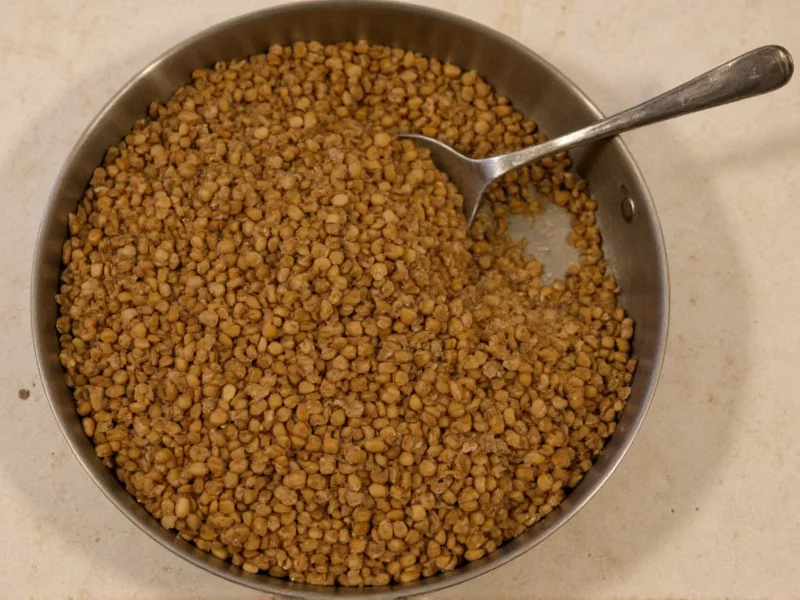Lentils are nutritional powerhouses packed with protein, fiber, vitamins, and minerals, but their gas-producing reputation is well-founded. Understanding why this happens and how to manage it can help you incorporate these healthy legumes into your diet without discomfort.
Why Lentils Cause Gas: The Science Explained
Lentils contain significant amounts of dietary fiber and oligosaccharides—specifically raffinose and stachyose. Unlike simple sugars, these complex carbohydrates resist digestion in the small intestine because humans lack the enzyme alpha-galactosidase needed to break them down.
When these undigested compounds reach your large intestine, gut bacteria ferment them, producing hydrogen, carbon dioxide, and sometimes methane gas as byproducts. This natural fermentation process causes the bloating, flatulence, and abdominal discomfort many people experience after eating lentils.
| Legume Type | Oligosaccharide Content (per 100g) | Typical Gas Production Level |
|---|---|---|
| Lentils | 1.5-2.0g | Moderate-High |
| Chickpeas | 2.0-2.5g | High |
| Black Beans | 2.5-3.0g | High |
| Split Peas | 1.0-1.5g | Moderate |
How Common Is Lentil-Induced Gas?
Research suggests 70-85% of people experience some degree of gas after consuming legumes like lentils, especially when first introducing them to their diet. Individual tolerance varies significantly based on:
- Gut microbiome composition: People with more diverse gut bacteria often adapt better
- Dietary history: Those from cultures with traditional legume consumption typically have better tolerance
- Amount consumed: Larger portions increase gas production
- Preparation methods: Proper cooking reduces problematic compounds
Effective Ways to Reduce Gas from Lentils
Don't let gas concerns prevent you from enjoying lentils' impressive health benefits. Try these evidence-based strategies to minimize digestive discomfort:
Proper Preparation Techniques
Soaking dried lentils for 8-12 hours before cooking reduces oligosaccharides by up to 30%. Discard the soaking water and rinse thoroughly before cooking. For canned lentils, rinse them well under cold water to remove excess oligosaccharides from the canning liquid.
Gradual Dietary Introduction
Start with small portions (¼ cup cooked lentils) 2-3 times weekly, gradually increasing over 3-4 weeks. This allows your gut bacteria to adapt and become more efficient at breaking down these compounds, significantly reducing gas production over time.
Digestive Enzyme Supplements
Alpha-galactosidase supplements (like Beano) taken before meals can help break down oligosaccharides. These over-the-counter enzymes reduce gas production by 25-70% according to clinical studies on legume consumption.
Strategic Food Pairing
Combining lentils with carminative herbs and spices can ease digestion. Try adding:
- Asafoetida (hing) - traditionally used in Indian cuisine with lentils
- Ginger - enhances digestive enzyme production
- Cumin seeds - reduces gas formation
- Fennel seeds - relaxes intestinal muscles
The Nutritional Benefits of Lentils Outweigh Temporary Discomfort
Despite their gas-producing potential, lentils offer exceptional nutritional value that makes them worth incorporating into your diet:
- High-quality plant protein: 18g per cooked cup, essential for muscle maintenance
- Soluble fiber: 15g per cup, improves cholesterol levels and blood sugar control
- Folate: 90% of daily value per cup, crucial for cell function and tissue growth
- Iron: Non-heme iron that supports oxygen transport in blood
- Low glycemic index: Helps maintain stable blood sugar levels
Long-term lentil consumption actually improves gut health by feeding beneficial bacteria. Most people's digestive systems adapt within 2-4 weeks of regular consumption, making gas issues temporary rather than permanent.
When to Consult a Healthcare Professional
While lentil-induced gas is normal, consult a doctor if you experience:
- Severe pain that doesn't improve with standard remedies
- Blood in stool
- Unintended weight loss
- Symptoms persisting beyond 4 weeks of consistent lentil consumption
These could indicate underlying conditions like irritable bowel syndrome (IBS), inflammatory bowel disease (IBD), or true lentil intolerance that requires medical evaluation.
Practical Tips for Enjoying Lentils Without Discomfort
Implement these simple strategies to make lentils more digestible:
- Cook lentils thoroughly until very soft—undercooked lentils are harder to digest
- Start with red or yellow lentils, which are generally easier to digest than green or black varieties
- Avoid eating lentils with other high-gas-producing foods like broccoli or carbonated drinks
- Chew lentils thoroughly to begin digestion in the mouth
- Stay hydrated to help fiber move through your digestive system
- Consider fermented lentil products like idli batter which have reduced oligosaccharides











 浙公网安备
33010002000092号
浙公网安备
33010002000092号 浙B2-20120091-4
浙B2-20120091-4